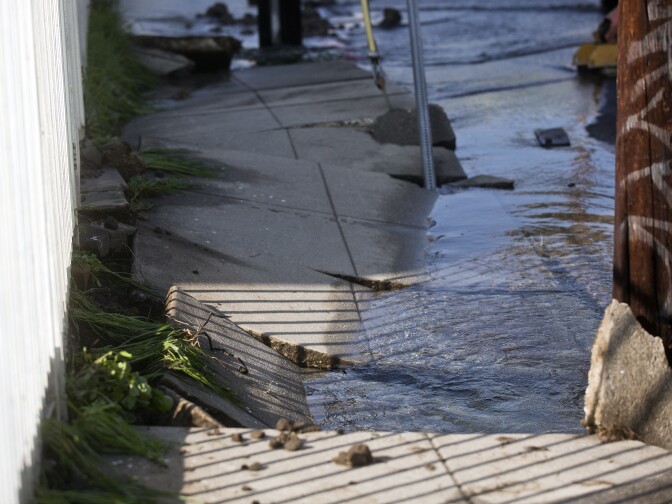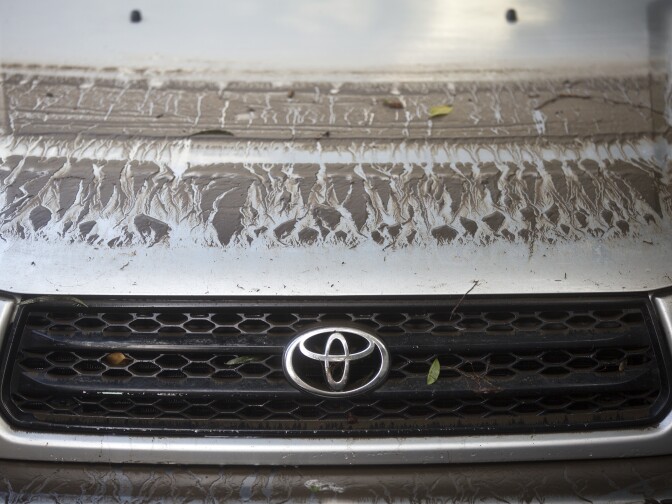With our free press under threat and federal funding for public media gone, your support matters more than ever. Help keep the LAist newsroom strong, become a monthly member or increase your support today.
Water main break submerges vehicles in Hollywood
Crews are still trying to repair an 18-inch main that burst early Wednesday in Hollywood, releasing a torrent of water onto residential streets and submerging cars.
The Los Angeles Department of Water and Power was called to the break on Dix Street near Cahuenga Boulevard shortly before 3 a.m.
"It sounded like a rain shower, and we looked outside and it wasn't. It was just a lot of water," resident Brenda Burror, whose family's cars were submerged, told KCBS-TV, according to the AP. "Right now we're trying to cancel work and school, see what we can do to fix the cars."
The noise woke Matthew Wosniak. He looked over his apartment's balcony and saw his roommates' cars buried in watery mud.
"It was all the way up to the hood, you can see the line of scum there, right to the roof," he told KPCC.
Wosniak recently moved to Los Angeles to work in the entertainment industry. The water that flooded his apartment house's parking lot also inundated his basement, where his senior projects from film school were stored.
Video taken at the scene earlier showed water continuing to flow hours after it began.
Tweets from Fox11's Sandra Endo showed water reaching almost to the roof of several cars.
DWP Senior Assistant General Manager Marty Adams said the 90-year-old pipe had no reported leaks in the past decade. In the system's A to F grading system, the Dix Street pipe was not considered at high risk for failure.
"This pipe was rated a C based on its material and its age and how it was installed, so it really was not on the radar screen as any kind of imminent problem," he said.
L.A. water mains spring about three leaks a day, but few cause damage like this. A slab of asphalt in the middle of Dix Street was thrust up five inches by the force of the water and the scouring away of soil beneath the pavement.
Between January 2010 and November 2014, the LADWP recorded 117 pipe leaks in the Hollywood Hills. Those leaky pipes tended to fit a pattern: 63 of the leaks, a majority, sprung from pipes installed in the 1920s. Most were made of either cast iron or steel, with 57 pipes of each type in the leak data.
Forty-five of those leaks were caused by rust holes, according to the LADWP’s data. LADWP spokeswoman Kim Hughes says that, over time, pipe metal can weaken and erode. Splits, essentially tears or ruptures in the pipes, were the cause of an additional 19 leaks in the Hollywood Hills since 2010.
Crews could be in the area for hours fixing the mess — past pipe repairs in the Hollywood Hills took LADWP workers an average of 21.5 hours to repair, with one fix eating up 58 hours of staff time. The data comes from the LADWP, and contains details about leaks since 2010, including the pipe material, location and the cause of the leak.
The DWP plans to spend about $1.3 billion dollars in the next decade to replace the city's worst pipes, those graded D and F. The money is likely to come from water rate increases, Adams said.
LADWP's Jeff Bray told KPCC earlier that he expected the Dix Street main to be fixed sometime Wednesday.
"We have the majority of the water shut off. But we still have a little bit of water that we’re having trouble with some of the valves, and we’re working those valves to get the water shut off completely," he said.
The state of LADWP pipes
The LADWP's pipe data shows an aging system. This graph shows when broken pipes were installed, with the pipes dating back to the 1920s highlighted in dark blue.
The LADWP has given a significant number of its own pipes "D" or "F" grades in assessing their likelihood of failure. Those pipes have a "high" or "very high" likelihood of failure, according to the department. The darker colors in the graph below indicate worse grades.
A small but significant number of pipes, just over 5%, are beyond what the department considers their "useful life". The dark blue below represents pipes past their useful life.
This story has been updated.



















